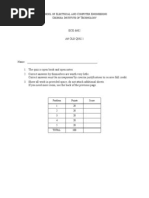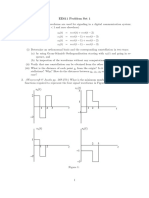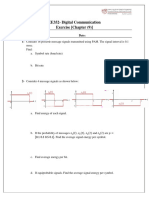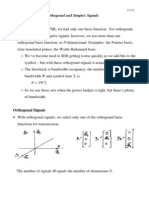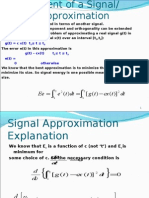Problem Set1
Uploaded by
qasim-ali-haidri-72Problem Set1
Uploaded by
qasim-ali-haidri-72EE611 Problem Set 1
1. The following four waveforms are used for signaling in a digital communication system: (rect(t) = 1 for 0 t < 1 and zero elsewhere) s0 (t) = rect(t) + rect(t 2) s1 (t) = rect(t 1) + rect(t 3) s2 (t) = rect(t 1) + rect(t 2) s3 (t) = rect(t 1) rect(t 3) (i) Determine an orthonormal basis and the corresponding constellation in two ways: (a) by using Gram-Schmidt Orthogonalisation starting with s0 (t) and going in sequence, and (b) by inspection of the waveforms without any computations. (ii) Verify that one constellation can be obtained from the other simply by rotation. (iii) What is the distance of each point si from the origin? Is it the same in both constellations? Why? How do the distances between s0 , s1 , s2 and s3 compare in either case? 2. (Wozencraft & Jacobs pp. 269-273:) What is the minimum number of orthonormal basis functions required to represent the four signal waveforms in Figure 1?
s0 (t)
2
s1 (t) 3
1 1 2 2 3
t
1
s2 (t)
s3 (t)
1 2 1 2 3
t
1
2 3
Figure 1:
f (t) 1 0.5 0 0.5 f (t) 3 0.5 0 0.5 1 2 2 4 t
f (t) 2 0.5 0 4 t
Figure 2: 3. Consider the three waveforms fn (t) shown in Figure 2. (a) Show that these waveforms are orthonormal. (b) Express the waveform x(t) as a weighted linear combination of fn (t), n = 1, 2, 3, if 3 2 x(t) = 1 0
(1 t < 2) (2 t < 3) (3 t < 4) else
and determine the weighting coecients.
4. A binary communication system uses the two waveforms shown in Figure 3 for signalling. Sketch a signal constellation representation of the signals.
s 1(t) A 0 T t A 0 A s 2(t) T 3T/4 t
Figure 3: 5. Sketch the decision region for the optimal receiver that minimizes probability of error when the signal constellation in Figure 4 is transmitted over an AWGN channel. Assume that the symbols are equally likely.
(1, 0.5)
(1, 0.5)
Figure 4:
You might also like
- Assignment 1 Communication Theory EE304: Submit QTS.: 4, 7, 10 (A, B, E), 12, 14, 16 and 17No ratings yetAssignment 1 Communication Theory EE304: Submit QTS.: 4, 7, 10 (A, B, E), 12, 14, 16 and 176 pages
- ECE376 Dimensionality of Signals ASK PSK QAM FSKNo ratings yetECE376 Dimensionality of Signals ASK PSK QAM FSK39 pages
- Student Solutions Manual to Accompany Economic Dynamics in Discrete Time, secondeditionFrom EverandStudent Solutions Manual to Accompany Economic Dynamics in Discrete Time, secondedition4.5/5 (2)
- Orthogonal Biorthogonal and Simplex SignalsNo ratings yetOrthogonal Biorthogonal and Simplex Signals17 pages
- Student Id:202015005 Date:23-Mar-21 Name: Anand TherattilNo ratings yetStudent Id:202015005 Date:23-Mar-21 Name: Anand Therattil3 pages
- Solution Manual For Introduction To Digital Communications - Ali GramiNo ratings yetSolution Manual For Introduction To Digital Communications - Ali Grami30 pages

